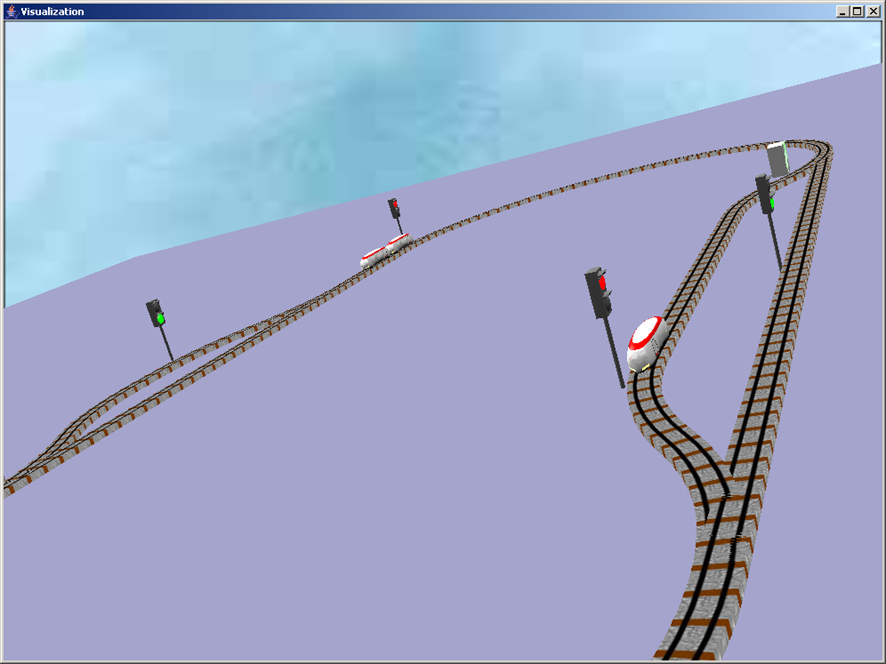In addition to the information on this page, there will be a presentation of the project (see slides) and the used technologies in the first weeks of this course, where you will also be able to ask your questions.
Petri nets can be used in many different application areas. In this project, the focus is on material flow systems and transport systems. In this application area, there are two major problems:
- Petri nets are discrete, which means that states change in steps. By contrast,
material flow and transportation systems are continuous — physical objects
do not jump.
- The graphical notation of Petri nets shows everything as a black token. Therefore it requires some excercise and education to relate the Petri net simulations to what really happens in the physical world.
 overcome this problem, different extensions of Petri nets have been
proposed that make it easy to equip a Petri net model with information on the
physical world and to visualize and animate the Petri net simulation in 3D.
This way, people that do not Petri net at all can see what is "really" going on
in a simulation and can even interact with the simulation.
overcome this problem, different extensions of Petri nets have been
proposed that make it easy to equip a Petri net model with information on the
physical world and to visualize and animate the Petri net simulation in 3D.
This way, people that do not Petri net at all can see what is "really" going on
in a simulation and can even interact with the simulation.
One tool that allowd to equip Petri nets with a 3D animation was PNVis (see article). Unfortunately, PNVis is a bit outdated, is based on a Petri net tool that no longer is supported, and uses outdated technology.
In the project of this course, the ideas and concepts behind PNVis should be re-implemented using model-based technology and a modern Petri net tool that follows the principles of model-based software engineerin, the ePNK.
Below, the main functionality and requirements of the tool are summarized, where the terminology of the PNVis article and the ePNK documentation is used (without introducing it again):
- A Petri Net Type for the ePNK that
adds the extensions of PNVis nets in some form or the other to
Place/Transition nets: animations, references to geometry
objects and shapes, token identities, ...
Note that by implementing such a Petri Net Type, the ePNK will provide a graphical editor for these kind of Petri nets.
- A simple graphical editor for geometries that define the geometry along
which the animated objects should move. There should be an EMF model defining
what the concepts of a geometry and the relation between geometry objects
are.
- A simple editor that defines the graphical appearance (shape) of the geometry
and the animated objects, and the scene's background. There should be an EMF
model for these concepts. Dependent on the clarity of that model, the
simple EMF tree editor that is automatically generated might do.
- A simple simulator for the extended Petri net type, that has an interface
for interacting with the 3D animation engine.
- A 3D visualisation that interacts with the simulation, so that the tokens
of the Petri net have corresponding objects in the 3D visualisation that
behave according to the defined animations.
- S simple graphical interface for starting, controlling (pause, reset, stop), and finishing different 3D animations on different or the same model at the same time.
In addition, there are the following requirements:
- All the model elements (Petri net, geometry, appeance model) should
be implemented in the MBSE philospphy (have a meta-model and some
code is generated from these models automatically).
- The runtime information that represent the current state of a Petri net
and the 3D animation, can be implemented and do not need to
have an EMF meta-model (but UML models should be included in the
documentation).
The Petri net models and the models behind a 3D animation should not change by starting and running a 3D animation. It should be possible to start several animations on the same model at the same time!
- The interface between the Petri net simulation and the 3D animation
enigne should be clear and simple, so that it would be easy to
exchange a Petri net simulator with other simulators.
- The animation should work smoothly on typical modern laptop computers
for medium size scenarios (in your detailed specification be specific
what exactly that means).
- The 3D models do not need to be too fancy, and it is up to the group
to decide which of the (common) formats they are using.
- The tool should come with a fully fledged example that demonstrates all the features and capabilities of the groups tool.
Therefore, you need to install Eclipse. This installation guide explains how to install Eclipse 4.3 and its extensions on your computer in the right configuration (with EMF, GMP/GMF, Xtext, OCL, Ecore Tools, and SVN subversion).
Once the groups are created, every group will be given access to a separate SVN repository. All the documents of the development process as well as the models and the software should be maintained in and accessible via this repository.
The ePNK for Eclipse 4.3 (Kepler) can be installed from the following Eclipse update site: http://www2.imm.dtu.dk/~ekki/projects/ePNK/kepler/update/. Use the Eclipse "Install New Software..." mechanism (you find that in Eclipse's Help menu). From that update site, you should select and install all features. The details will be explained in one of the tutorials. But, for understanding the project, you should have a look at the ePNK documentation already now.